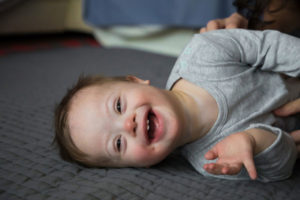Cloth diapering is better for your baby, environment, and your wallet.
Compared to disposables, the benefits of switching to reusable cloth diapers and training pants are countless.
With the incredibly soft and super absorbent fabrics that also come in a wide variety of fun colors, significantly less rash and a reduced amount of chemicals exposed to your little one, there is absolutely every reason to consider cloth as the best natural diaper solution for your baby.
The amount of money you can save with cloth diapers is quite huge! Ditching disposable diapers will have you saving to the tune of $2000 per child, which is pretty impressive.
If you’re running on a strict budget, cloth diapering is definitely the way to go. But…
What if Your Child Has Special Needs?
With more cases of Down’s Syndrome, Autism, and other health issues on the rise, the topic of diapering children with special needs is worth considering.
For kids with special needs, all the benefits of using cloth diapers still matter. In fact, even more.
Diapering a special needs child can be a challenge especially when issues like extreme skin sensitivity, food intolerance, and other issues are at play.
And when you add up the cost of using disposable diapers for longer periods other than the standard 2-3 diapering phase of the child, you might end up going crazy thinking about how much the cost of buying disposables will add to.
We are talking about thousands of dollars for a few years, if not more.
My boy John has finally learned how to go potty, just one week before turning 6.
I am ecstatic! If we had not switched to cloth diapers and used disposables all those years, we could have easily bought a brand new car with the same amount of money we would have spent on disposables.
It’s definitely a huge difference.
Background:
I am a mother of four kids and about 10 years ago, I began my cloth diapering journey. John, my second born, was born two years later and has Down’s Syndrome.
Because I used cloth diapers on my first child, I had everything I needed to make diapering my son a much easier job, and it was. We knew he was going to be different from the average child even before he was born.
We also knew he was going to learn at a different pace, take a little bit longer to do things that other kids do with ease like crawling, sitting, walking, and more.
Like it is with most special needs kids, a lot of things were quite challenging for our little John right from the start.
Honestly, we really had a hard time learning about all these new changes about him.
We also found ourselves making a lot of hospital visits and spending a lot of time there helping him recover from all the surgeries and an array of health complications. It wasn’t easy.
Cloth diapering John wasn’t really hard as we already had the experience from our first child. I never really thought of it that much.
However, right after John reached the 2-3 years potty training phase, that’s when it began to dawn on me that there was a big difference in cloth diapering a child with special needs.
Our boy was clearly not ready to learn this new thing, potty training!
But despite all the helpful suggestions from the less understanding family members, there was no way I was going to keep postponing it. I am the one who perfectly understood him- better than anyone else.
At that phase, my little boy wasn’t even at a point where learning how to potty meant anything to him. He was just trying to learn how to walk and talk.
I knew it wasn’t going to be easy and that it was definitely going to take longer than usual but honestly, I had no idea when it was going to happen.
However, one thing I was sure of is that I wasn’t going to start during that time. Don’t get me wrong though.
I definitely love cloth diapering John, but not having to use them at all is obviously a much better option.
Of course, I am not trying to imply that I understand everything there is to know about cloth diapering a child with special needs.
All I know is what my experiences have been during that phase.
Without a doubt, every single child is different and will learn potty training at their own pace.
You just need to keep in mind that when dealing with a special needs child, whether they are developmental, physical, behavioral, or a combination of different factors, learning potty training is usually an extended process that may not even start for several years after an average child has already mastered the same skill.
Special Needs, Special Cloth Diapering Needs:
For children with special needs, especially developmental delays, their bodies and brains develop at a different pace compared to the average need kids.
They often require more repetition to learn and understand certain things.
For example, while it would only take a few tries for an average child to learn how to use a sippy cup, a child with special needs would need a lot more time to learn the same -could be weeks or more.
Therefore, when it comes to potty training, it’s highly advisable that the child wears diapers or training pants that can be pulled on and off without much struggle and also allow them to feel the wetness when they go.
In this case, consistency is key when it comes to building the right potty training habits.
One of the biggest challenges of diapering a child with special needs is finding the right size.
Another challenge is that some special needs kids have additional needs such as requiring certain types of diapers that work well with low muscle tone or lower levels of coordination.
Therefore, if the little one is trying to up the diaper or training pants independently, it must be flexible enough to allow this while still providing a comfortable, secure fit.
Kids with significantly reduced motor control may manage just well with larger diapers.
However, the ability to easily snap off in the event of an accident makes them invaluable assets.
Considering the fact that a child with special needs will be wearing diapers or trainers longer than usual, it’s important to have a diapering solution that lasts longer than one size.
In this case, one-size training pants are often considered valuable as they have this special elastic that allows you to adjust the size internally while preventing your little one from messing around with the pants.
One-size training pants are also suitable for children weighing from 20 to 50 lbs upwards and still provide a very comfortable fit.
The good thing is that with John, we had lots of opportunities to test them out.
They were extremely helpful when we moved from diapers for an older child to the independence of training pants. And at last, the joy of seeing our child fully potty trained is tremendous!
The time to begin cloth diapering children with additional needs can be a little bit different than those without. Some parents start cloth diapering from an early age in the hopes to save some money.
If you have a child with special needs, you have a much better opportunity to use reusable cloth diapers and end up saving a huge amount of money in the long run.
All in all, regardless of your reasons for cloth diapering, whether you have a special needs child or not, or whether you use cloth diapers full time or not, every single diaper change can make a huge difference for your little one, the environment, and even your budget.

As a mother of four very energetic children, Emilia knows how chaotic motherhood can be. She’s learned a lot of lessons along the journey so far and loves sharing the tips & tricks she’s picked up over the years with anybody else on the same life path.

